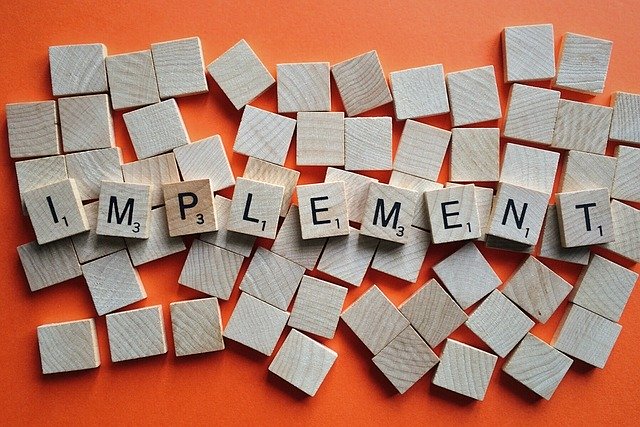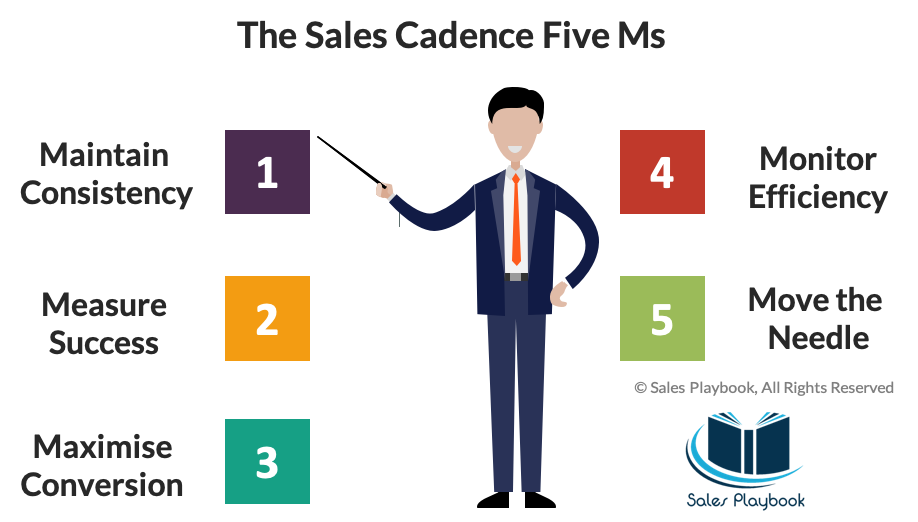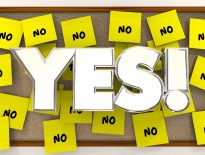
A sales cadence, also referred to as a sales sequence, is a timeline of activities sales reps follow to engage with prospects. Touchpoints in a cadence can include calling, emailing, text messaging, video messaging, voicemails and messaging through social channels like LinkedIn. By supplying sales reps with cadence templates they always know what to do next and can focus on continually advancing prospects and making sure there is a continuous flow of opportunities along the stages of their sales pipeline.
It’s important to have your sales cadences included in your Sales Playbook so everyone in your sales team has access to best practices.

Having a well-defined sales cadence not only helps your sales reps work more efficiently, but it makes the steps in your sales process run more smoothly, especially during prospecting and discovery. The five Ms are the key benefits of implementing a strong cadence structure:
- Maintain Consistency – Provides a set of specific and common activities for your sales team to follow
- Measure Success – Keeps everything continuous, helping sales reps manage and optimise their sales pipeline
- Maximise Conversion – By removing the chance of forgetting to engage prospects this boosts productivity and in turn a sales teams potential to convert
- Monitor Efficiency – Using a CRM to track activities enables managers to adjust or remove a cadence accordingly
- Move the Needle – Allows businesses to quickly scale, such as growing a sales team or doubling a reps sales pipeline
Outbound vs Inbound Sales Cadences
Outbound sales cadences are generally aimed towards cold prospects and will typically vary in duration with touchpoints spread further apart than Inbound cadences. This is to slowly nurture the prospect instead of over expressing your interest too rapidly and potentially scaring them away. The duration and touchpoints of your sales sequence will be based around a number of factors. For example, targeted personas, communication preferences, the length of your company’s sales cycle, where the lead originated, etc. When creating your outbound cadence it’s worth considering when calling if the phone call is not answered and no message is left then the buyer will not be aware that contact has been attempted, so phone calls would be added into a cadence more frequently, but if you email, InMail or leave voicemails, then the next attempt will be spread further apart.
Inbound cadences on the other hand are targeting a more warmer prospect. These leads may have come through from a website enquiry or marketing activity, so there is an interest in your product or service. These leads should be applied to a cadence as soon as they drop into a sales reps lead queue and followed up immediately by phone.
There should be sequences set up for both outbound and inbound prospects that are ready to go for your sales reps. The cadences created need to be manageable, so that changes can be made when necessary. A small amount of cadences for both should be enough. Having too many cadences can make it difficult to gauge which ones are successful and in turn confuse reps around which ones to use and when. Simply put cadences become unmanageable.
I experienced this when working for a company that had over 400 cadences and a team of only four BDRs (Business Development Representatives). The cadences were all similar in duration and touchpoints and by allowing the individual reps to create their own cadences with no guidelines they had created too many sequences, many with no benefit and having all of these in the CRM had become chaotic.
Once you create your sales cadences remember to A/B test them to find out which ones have the most success and make sure those are used by your whole team. The successful cadences should be added to your company’s Sales Playbook and the unsuccessful sequences should be removed from the CRM.
Account Based Selling Cadences
If you’re doing account based selling then you’re likely prospecting to the biggest brands or industry leaders which will require hyper-personalised outreach. You’ll be messaging and calling decision makers, but should also focus on building rapport with personal assistants/gatekeepers as these can be potential influencers to the decision maker due to their daily interaction.
ABS or account based selling should be determined at a business’s leadership level as this is more time consuming for sales reps due to the higher amount of research and hyper-personalised approach required.
Account based selling is typically used when selling into enterprise level accounts and to C-level personas. Businesses need to be careful not to make the mistake of using this as a standard approach for all prospects. I have seen companies that ask their sales team to focus on account based selling when they really didn’t need to and this lead to time being wasted and under performance from their reps. If you will be dealing with a mixture of enterprise, mid-market and small business companies then you’ll need cadences to approach all of these in a different way. Account based selling is unlikely to be required for mid-market and small business accounts, so sales cadences could potentially be shorter and more generic in approach. Making sure the different outreach sequences are available and guidance of which ones to use is clear will enable you to be more successful when targeting different types of businesses.
Sales Cadence Examples
Outbound Sequences – Short
This cadence covers 14 touchpoints. The action taken in the morning is followed up by another in the afternoon.
Day 1: Email in the morning, phone call in the afternoon
Day 3: Phone call in the morning, phone call in the afternoon with voicemail
Day 5: Phone call in the morning, LinkedIn InMail in the afternoon
Day 8: Phone call in the morning, phone call in the afternoon with voicemail
Day 10: Email in the morning, phone call in the afternoon
Day 12: Phone call in the morning, email in the afternoon
Take a two week rest period before adding to another sequence.
Outbound Sequence – Long
This cadence covers 22 touchpoints. The cadence covers a broader range of activities over a longer period
Day 1: Email
Day 3: Phone call in the morning, phone call in the afternoon
Day 4: Phone call in the morning, phone call in the afternoon with voicemail
Day 5: LinkedIn InMail
Day 8: Phone call in the morning, phone call in the afternoon
Day 9: Phone call in the morning, phone call in the afternoon with voicemail
Day 11: Email
Day 13: Video message
Day 16: Phone call in the morning, phone call in the afternoon
Day 17: Phone call in the morning, phone call in the afternoon with voicemail
Day 19: Phone call in the morning, phone call in the afternoon
Day 20: Email
Take a two week rest period before adding to another sequence.
Inbound Response Sequence
Inbound leads, depending on the source, are classed as hot leads or hand-raisers, so when building a cadence you can comfortably reach out more often. How quickly sales reps respond to an inbound lead greatly impacts the conversion rate, so these should be actioned immediately. This cadence starts with high volume calling including written communication and voicemails, but slowly fades towards the backend if contact isn’t established.
Day 1: Phone call in the morning with voicemail, LinkedIn InMail in the afternoon
Day 2: Phone call in the morning with voicemail, email in the afternoon
Day 3: Phone call in the morning, phone call in the afternoon with voicemail
Day 5: Phone call in the morning, email in the afternoon
Day 7: Phone call with voicemail
Day 9: Phone call in the morning, phone call in the afternoon
Day 10: LinkedIn InMail
Day 14: Email
Day 18: Phone call in the morning, phone call in the afternoon with voicemail
Day 21: Email
Take a one week rest period before adding to another sequence.
Account Based Selling Sequence
All communication needs to be hyper-personalised around solutions from in-depth research that has been done to fully understand the prospects business and problems. Where voicemails aren’t available, rapport should be built with gatekeepers/personal assistants.
Day 1: Targeted personalised email
Day 3: Phone call with voicemail
Day 4: LinkedIn InMail with personalised message
Day 7: Phone call in the morning, phone call in the afternoon (no message)
Day 10: Send a follow up personalised email forwarding the original email
Day 15: Send a third personalised email in a new thread with new added value
Day 17: Phone call with voicemail
Day 20: Follow up LinkedIn message
Day 25: Phone call in the morning, phone call in the afternoon
Day 30: Follow up email
Take a two week rest period before adding to another sequence
The Importance of a Sales Cadence for New Hires
Depending on the size and structure of an organisation the initial cold outreach and response to inbound leads might be actioned by a sales development or business development team. Due to the shortage of experienced sales professionals these new hires will typically be fresh out of University or College and it could well be there first job. Having a sales cadence set up that works and is ready to go enables them to ramp up quickly and ease into their new role, rather than struggling to design their own outreach with no prior knowledge of sales.
Even experienced sales professionals will benefit from ready-made, tried and tested sequences, so when they need to continually prop up their sales pipeline they have the tools to do so at their disposal. Making sure the most recent and most successful sales cadences are included in your company’s Sales Playbook is imperative to building and sustaining a great sales team.
In Conclusion
A sales cadence helps your sales team navigate the rough terrain of lead generation. They keep your team’s momentum more consistent and their performance more measurable.
Making sure your sales team have access to as many tools as possible means they can try out different models and regular split testing should be done, which means a business will have a continuous flow of sales cadences that work.
“There’s no lotion or potion that will make sales faster and easier for you. Unless your potion is hard work”
Thanks for reading. If you enjoyed this article please like below and share on your social channels.


